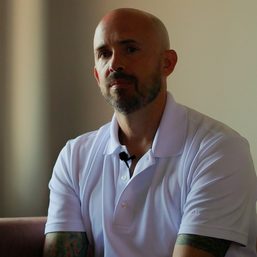SUMMARY
This is AI generated summarization, which may have errors. For context, always refer to the full article.
![[DASH of SAS] Lessons about intersections of migrant life, sexuality, inter-racial relationships](https://www.rappler.com/tachyon/2023/12/TL-Lessons-migrant-life-December-27-2023.jpg)
A while back, a migrant rights organization in the United Kingdom invited me to give a talk. I readily said yes, thinking that they would ask me to talk about labor migration policy. Actually, they told me, the women members had requested a discussion about sexuality and pleasure, specifically in the context of inter-racial relationships.
I was absolutely thrilled, although I have to admit, a bit surprised. Various organizations have invited me to give talks on sexuality, but it was the first time a migrant rights organization had asked me to do so.
I was living in London at the time and had just completed my postgraduate degree in Gender & Sexuality. My year abroad as an adult gave me first-hand experience of the migrant life I had spent many years writing about as a journalist. My graduate degree, meanwhile, gave me the academic space to examine the many intersections of migrant life – such as sexuality.
That talk surfaced my own unconsciously narrow view of migrant life as seen by my expectation to talk about labor rights and gaps in government policy. These are aspects of migrant life that I had been accustomed to writing about and trained to examine. Sexuality, as an integral part of migrant life is hardly spoken about, and as I had learned, there is much to talk about and learn.
Inter-racial relationships mean different sexual languages
For countries that are a source of migrant labor such as the Philippines, the demand for conventionally gendered jobs such as nursing and domestic work in certain countries of destination means that more women are leaving to work abroad.
More Filipino women going abroad translates to a higher probability of being in a relationship with someone who is not Filipino. Apart from the usual cultural differences that come with an inter-racial relationship, there are also differences in what I will call “sexual language.”
I use sexual language to mean how we want to express our sexuality through the giving, showing, and receiving of sexual pleasure. Sexual language also includes the interpretation and meaning we ascribe to certain sexual acts.
Based on those who had disclosed their relationship status, all of the participants were romantically involved with men. Their main concern was how to navigate different sexual languages with a partner with a different upbringing, cultural background, and value system when it comes to sex.
They wanted to please their partners but the different sexual acts that were now available to them had them richoceting through a rollercoaster of emotions that included shock and embarrassment.
They were also conflicted and a bit confused. For example, some women had difficulty accepting and giving oral sex. They worried about how they would be perceived by their partner if they participated in oral sex too enthusiastically or enjoyed it too much – or too little. Would they be seen as too experienced? Too loose? Too uptight? Too hungry for sex?
Basically, the women were torn between pleasing their partner and wrestling with the social conditioning that told them that how they have sex is linked to their moral values. In short, how they have sex determines if they are the good, decent Filipino woman – dalagang Filipina – that many of us were raised to emulate and aspire to become.
Unpacking social conditioning, translating it into a mutual sexual language
The uneasiness of the women (which I think many of us have found ourselves facing, in one way or another) can be traced back to our social conditioning or the everyday things that tell us what an “ideal” partner and relationship look like.
These include how friends and family react to, speak about, and treat people who are not in monogamous heterosexual relationships or do not conform to heteronormative gender norms and expectations.
Movies, films, and TV shows leave us with impressions (and fantasies) about what love and sex should feel like. Meanwhile, laws that regulate how we function as a society tell us what is permissible and what is “criminal.” For example, the stubborn divorce ban and the criminalization of abortion even in cases that would endanger the life of the pregnant person, underwrite our understandings of marriage and bodily autonomy.
Our social conditioning also forms the basis for the hierarchy of sexual acts, which gender theorist Gayle Rubin called “The Charmed Circle.” This is largely premised on heteronormativity, positions penis and vagina sex at the top and the only legitimate, natural way to have and enjoy sex. Other sex acts such as oral or anal sex are relegated as deviant or perverse.
We grow up exposed to this social conditioning and as adults engaging in and exploring romantic relationships, these influences form the backbone of our own personal beliefs and sexual value system. (WATCH: #AskMargie: Oral Sex and READ: [Dash of SAS] Cliteracy: Of penises and patriarchy.)
Unpacking social conditioning to understand different sexual languages
Social conditioning and our sexual values system also outline our emotional interpretations of sexual acts. Through it we interpret sexual acts by how we see ourselves and how we perceive our partners seeing us.
For example, the women wanted to know how to tell if a sexual act is an expression of intimacy or a veiled assertion of dominance and subjugation. Together, we unpacked the meanings we attribute to sexual acts. We focused on consent – how it should be given (always), expressed (explicitly), and can be revoked (if wanted) as central to mutually enjoyable sexual exploration. We talked about how through honest, but maybe difficult conversations with our partners, we can better understand different sexual languages.
We ended that evening thinking about how we could pleasure and please our partners while also being true to ourselves and protecting our self-concept.
For me, I got a deeper understanding of how life abroad can also be a form of liberation. The anonymity offered by living in a foreign country gives space that is free from the judgment of family and friends, the conventions of society, and the expectations of people who may have known you for a long time.
There was also a point of reckoning.
Of course, I will continue to seek out, expose, and write about the unjust exploitation of migrant workers. But after that talk, I made a promise to myself to also explore and write about the other chapters of migrant life – the ones that are made up of stories of joy, of pleasure, of the sometimes kilig but sometimes confusing experience of dating in a country that is not your own.
Study after study has shown us that the quality of our relationships determine the quality of our lives. In Philippine society, especially among OFWs, our relationships with our family are our core. But relationships also include romantic ones, sexual ones – often overlooked in migrant life – but also determine our happiness.
When we talk about migrant life through the lens of hardship and oppression, we center discussions around risk and danger. We inadvertently minimize migrants to their migration status and the precarity of their working conditions. We box them into a class and background that is different from ours. But what if we included romantic relationships and expressions of sexuality as part of migrant life? What if we normalized the everyday experiences of migrant life and celebrated OFWs not only for their sacrifice, but also for their grit to navigate the complexities of life like romantic relationships – just like you and me? – Rappler.com
Ana P. Santos is an investigative journalist and writer who writes about the intersections of gender, sexuality, and labor migration. She completed a postgraduate degree in Gender (Sexuality) from the London School of Economics and Political Science as a Chevening Scholar. Follow her on Instagram at @anaallsaints.
DASH of SAS is a spin off of her videos on sexuality entitled “Sex and Sensibilities” (SAS). Watch here.
Add a comment
How does this make you feel?






![[Two Pronged] I still love my husband, but I’m having an affair with my ex-boyfriend](https://www.rappler.com/tachyon/2024/07/tp-first-love.jpg?resize=257%2C257&crop=269px%2C0px%2C720px%2C720px)
![[DASH OF SAS] Your privilege won’t protect you](https://www.rappler.com/tachyon/2024/07/divorce-violence-against-women.jpg?resize=257%2C257&crop_strategy=attention)
![[Two Pronged] Am I losing my libido now that I’m hitting my 40s?](https://www.rappler.com/tachyon/2024/07/two-pronged-forties-libido.jpg?resize=257%2C257&crop_strategy=attention)











There are no comments yet. Add your comment to start the conversation.